Ultrafast-Laser-Induced Tailoring of Crystal-in-Glass Waveguides by Precision Partial Remelting
Abstract
1. Introduction
2. Materials and Methods
3. Results
3.1. Direct Laser Writing of Continuous Crystalline Tracks
3.2. Laser-Induced Partial Remelting of the Crystalline Tracks
4. Discussion
Author Contributions
Funding
Data Availability Statement
Conflicts of Interest
References
- Sugioka, K.; Ya, C. Femtosecond laser three-dimensional micro-and nanofabrication. Appl. Phys. Rev. 2014, 1, 041303. [Google Scholar] [CrossRef]
- Wang, X.; Yu, H.; Li, P.; Zhang, Y.; Wen, Y.; Qiu, Y.; Liu, Z.; Peng, Y.; Liu, L. Femtosecond laser-based processing methods and their applications in optical device manufacturing: A review. Opt. Laser Technol. 2021, 135, 106687. [Google Scholar] [CrossRef]
- Komatsu, T.; Honma, T. Laser patterning and growth mechanism of orientation designed crystals in oxide glasses: A review. J. Solid State Chem. 2019, 275, 210–222. [Google Scholar] [CrossRef]
- Stone, A.; Sakakura, M.; Shimotsuma, Y.; Stone, G.; Gupta, P.; Miura, K.; Hirao, K.; Dierolf, V.; Jain, H. Directionally controlled 3D ferroelectric single crystal growth in LaBGeO5 glass by femtosecond laser irradiation. Opt. Express 2009, 17, 23284–23289. [Google Scholar] [CrossRef] [PubMed]
- Stone, A.; Sakakura, M.; Shimotsuma, Y.; Miura, K.; Hirao, K.; Dierolf, V.; Jain, H. Unexpected influence of focal depth on nucleation during femtosecond laser crystallization of glass. Opt. Mater Express 2011, 1, 990–995. [Google Scholar] [CrossRef]
- Stone, A.; Jain, H.; Dierolf, V.; Sakakura, M.; Shimotsuma, Y.; Miura, K.; Hirao, K.; Lapointe, J.; Kashyap, R. Direct laser-writing of ferroelectric single-crystal waveguide architectures in glass for 3D integrated optics. Sci. Rep. 2015, 5, 10391. [Google Scholar] [CrossRef] [PubMed]
- Lipatiev, A.S.; Lipateva, T.O.; Lotarev, S.V.; Presnyakov, M.Y.; Fedotov, S.S.; Sigaev, V.N. Direct laser writing of LaBGeO5 crystal-in-glass waveguide enabling frequency conversion. Cryst. Growth Des. 2017, 17, 4670–4675. [Google Scholar] [CrossRef]
- Stone, A.; Sakakura, M.; Shimotsuma, Y.; Miura, K.; Hirao, K.; Dierolf, V.; Jain, H. Femtosecond laser-writing of 3D crystal architecture in glass: Growth dynamics and morphological control. Mater. Design 2018, 146, 228–238. [Google Scholar] [CrossRef]
- McAnany, S.D.; Veenhuizen, K.J.; Kiss, A.M.; Thieme, J.; Nolan, D.A.; Aitken, B.G.; Dierolf, V.; Jain, H. Evolution of glass structure during femtosecond laser assisted crystallization of LaBGeO5 in glass. J. Non-Cryst. Solids 2021, 551, 120396. [Google Scholar] [CrossRef]
- Lipatiev, A.; Lotarev, S.; Lipateva, T.; Okhrimchuk, A.; Fedotov, S.; Lotnyk, A.; Sigaev, V. Fabrication of single-mode hybrid crystal-glass waveguides by direct femtosecond laser writing and thermal annealing. Mater. Res. Bull. 2022, 152, 111840. [Google Scholar] [CrossRef]
- Cao, J.; Mazerolles, L.; Lancry, M.; Brisset, F.; Poumellec, B. Modifications in lithium niobium silicate glass by femtosecond laser direct writing: Morphology, crystallization, and nanostructure. J. Opt. Soc. Am. B 2017, 34, 160–168. [Google Scholar] [CrossRef]
- Cao, J.; Lancry, M.; Brisset, F.; Mazerolles, L.; Saint-Martin, R.; Poumellec, B. Femtosecond Laser-Induced Crystallization in Glasses: Growth Dynamics for Orientable Nanostructure and Nanocrystallization. Cryst. Growth Des. 2019, 19, 2189–2205. [Google Scholar] [CrossRef]
- Veenhuizen, K.; McAnany, S.; Vasudevan, R.; Nolan, D.; Aitken, B.; Jesse, S.; Kalinin, S.V.; Jain, H.; Dierolf, V. Ferroelectric domain engineering of lithium niobate single crystal confined in glass. MRS Commun. 2019, 9, 334–339. [Google Scholar] [CrossRef]
- Veenhuizen, K.; Barker, C.; Franklin, J.; McAnany, S.; Aitken, B.; Nolan, D.; Dierolf, V.; Jain, H. The role of glass composition in the 3D laser fabrication of lithium niobate single crystal in lithium niobosilicate glass. Opt. Mater. 2022, 128, 112380. [Google Scholar] [CrossRef]
- Dai, Y.; Zhu, B.; Qiu, J.; Ma, H.; Lu, B.; Cao, S.; Yu, B. Direct writing three-dimensional Ba2TiSi2O8 crystalline pattern in glass with ultrashort pulse laser. Appl. Phys. Lett. 2007, 90, 181109. [Google Scholar] [CrossRef]
- Lipatiev, A.S.; Moiseev, I.A.; Lotarev, S.V.; Lipateva, T.O.; Presnyakov, M.Y.; Fedotov, S.S.; Sigaev, V.N. Growth of fresnoite single crystal tracks inside glass using femtosecond laser beam followed by heat treatment. Cryst. Growth Des. 2018, 18, 7183–7190. [Google Scholar] [CrossRef]
- He, X.; Liu, Q.; Lancry, M.; Brisset, F.; Poumellec, B. Space-selective control of functional crystals by femtosecond laser: A comparison between SrO-TiO2-SiO2 and Li2O-Nb2O5-SiO2 glasses. Crystals 2020, 10, 979. [Google Scholar] [CrossRef]
- Lotarev, S.V.; Lipatiev, A.S.; Lipateva, T.O.; Lopatina, E.V.; Sigaev, V.N. Ultrafast laser-induced crystallization of lead germanate glass. Crystals 2021, 11, 193. [Google Scholar] [CrossRef]
- Lotarev, S.V.; Lipat’ev, A.S.; Kalmykova, K.S.; Lipat’eva, T.O.; Sigaev, V.N. Crystalline line formation from lithium heptagermanate in lithium germanate glass. Glass Ceram. 2022, 79, 295–299. [Google Scholar] [CrossRef]
- Komatsu, T.; Ihara, R.; Honma, T.; Benino, Y.; Sato, R.; Kim, H.G.; Fujiwara, T. Patterning of non-linear optical crystals in glass by laser-induced crystallization. J. Am. Ceram. Soc. 2007, 90, 699–705. [Google Scholar] [CrossRef]
- Honma, T.; Komatsu, T.; Benino, Y. Patterning of c-axis-oriented Ba2TiX2O8 (X = Si, Ge) crystal lines in glass by laser irradiation and their second-order optical nonlinearities. J. Mater. Res. 2008, 23, 885–888. [Google Scholar] [CrossRef]
- Gupta, P.; Jain, H.; Williams, D.B.; Honma, T.; Benino, Y.; Komatsu, T. Creation of ferroelectric, single-crystal architecture in Sm0.5La0.5BGeO5 glass. J. Am. Ceram. Soc. 2008, 91, 110–114. [Google Scholar] [CrossRef]
- Komatsu, T.; Koshiba, K.; Honma, T. Preferential growth orientation of laser-patterned LiNbO3 crystals in lithium niobium silicate glass. J. Solid State Chem. 2011, 184, 411–418. [Google Scholar] [CrossRef]
- Lotarev, S.V.; Gelmanova, T.O.; Priseko, Y.S.; Paleari, A.; Sigaev, V.N. Local laser-induced crystallization of lanthanum boron germanate glass near LaBGeO5 composition. Proc. SPIE 2011, 8306, 830619. [Google Scholar]
- Nishii, A.; Shinozaki, K.; Honma, T.; Komatsu, T. Morphology and orientation of β-BaB2O4 crystals patterned by laser in the inside of samarium barium borate glass. J. Solid State Chem. 2015, 221, 145–151. [Google Scholar] [CrossRef]
- Stone, A.; Jain, H.; Dierolf, V.; Sakakura, M.; Shimotsuma, Y.; Miura, K.; Hirao, K. Multilayer aberration correction for depth-independent three-dimensional crystal growth in glass by femtosecond laser heating. J. Opt. Am. Soc. B 2013, 30, 1234–1240. [Google Scholar] [CrossRef]
- Lipatiev, A.S.; Lotarev, S.V.; Smayev, M.P.; Lipateva, T.O.; Karateev, I.A.; Presnyakov, M.Y.; Fedotov, S.S.; Sigaev, V.N. Space-selective crystallization of glass by an optical vortex beam. CrystEngComm 2020, 22, 430–434. [Google Scholar] [CrossRef]
- Lipatiev, A.S.; Lotarev, S.V.; Okhrimchuk, A.G.; Lipateva, T.O.; Fedotov, S.S.; Sigaev, V.N. Crystal-in-glass architecture engineering: Writing, erasing and rewriting by a femtosecond laser beam. CrystEngComm 2018, 20, 3011–3015. [Google Scholar] [CrossRef]
- Lotarev, S.V.; Lipatiev, A.S.; Lipateva, T.O.; Fedotov, S.S.; Naumov, A.S.; Moiseev, I.A.; Sigaev, V.N. Ultrafast-laser vitrification of laser-written crystalline tracks in oxide glasses. J. Non-Cryst. Solids 2019, 516, 1–8. [Google Scholar] [CrossRef]
- Sigaev, V.N.; Lipat’ev, A.S.; Fedotov, S.S.; Lotarev, S.V.; Shakhgil’dyan, G.Y.; Naumov, A.S.; Savinkov, V.I. Femtosecond laser modification of antimony-containing lithium-aluminum-silicate glass and transparent sitall obtained from it. Glass Ceram. 2020, 76, 370–373. [Google Scholar] [CrossRef]
- Lipatiev, A.; Fedotov, S.; Lotarev, S.; Naumov, A.; Lipateva, T.; Savinkov, V.; Shakhgildyan, G.; Sigaev, V. Direct laser writing of depressed-cladding waveguides in extremely low expansion lithium aluminosilicate glass-ceramics. Opt. Laser Technol. 2021, 138, 106846. [Google Scholar] [CrossRef]
- Kaminskii, A.A.; Butashin, A.V.; Maslyanizin, I.A.; Mill, B.V.; Mironov, V.S.; Rozov, S.P.; Sarkisov, S.E.; Shigorin, V.D. Pure and Nd3+-, Pr3+-ion doped trigonal acentric LaBGeO5 single crystals. Phys. Stat. Sol. A 1991, 125, 671–696. [Google Scholar] [CrossRef]
- Takahashi, Y.; Benino, Y.; Fujiwara, T.; Komatsu, T. Second harmonic generation in transparent surface crystallized glasses with stillwellite-type LaBGeO5. J. Appl. Phys. 2001, 89, 5282–5287. [Google Scholar] [CrossRef]
- Nikogosyan, D.N. Nonlinear Optical Crystals: A Complete Survey; Springer: New York, NY, USA, 2005; p. 300. [Google Scholar] [CrossRef]
- Couairon, A.; Mysyrowicz, A. Femtosecond filamentation in transparent media. Phys. Rep. 2007, 441, 47–189. [Google Scholar] [CrossRef]
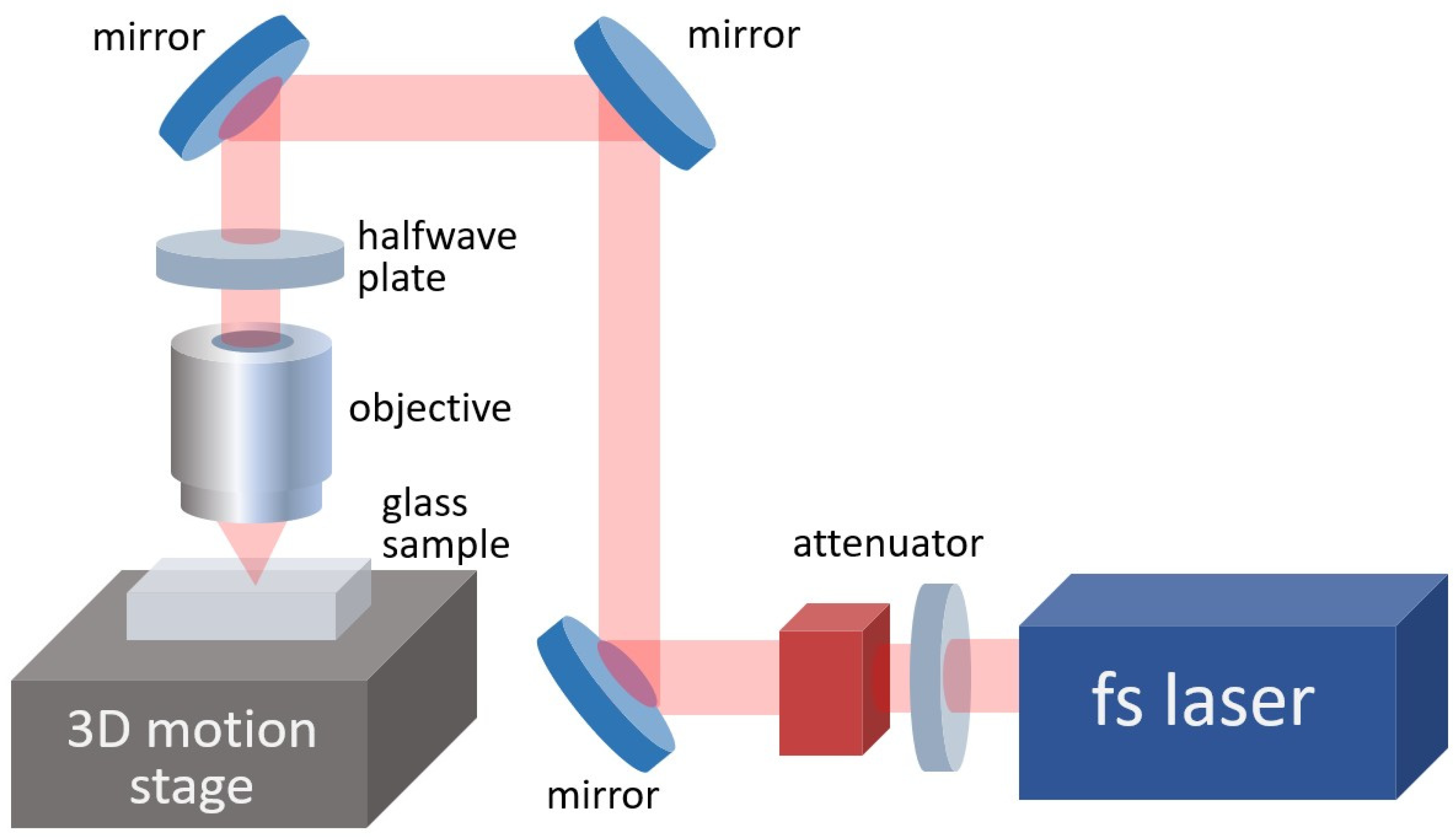
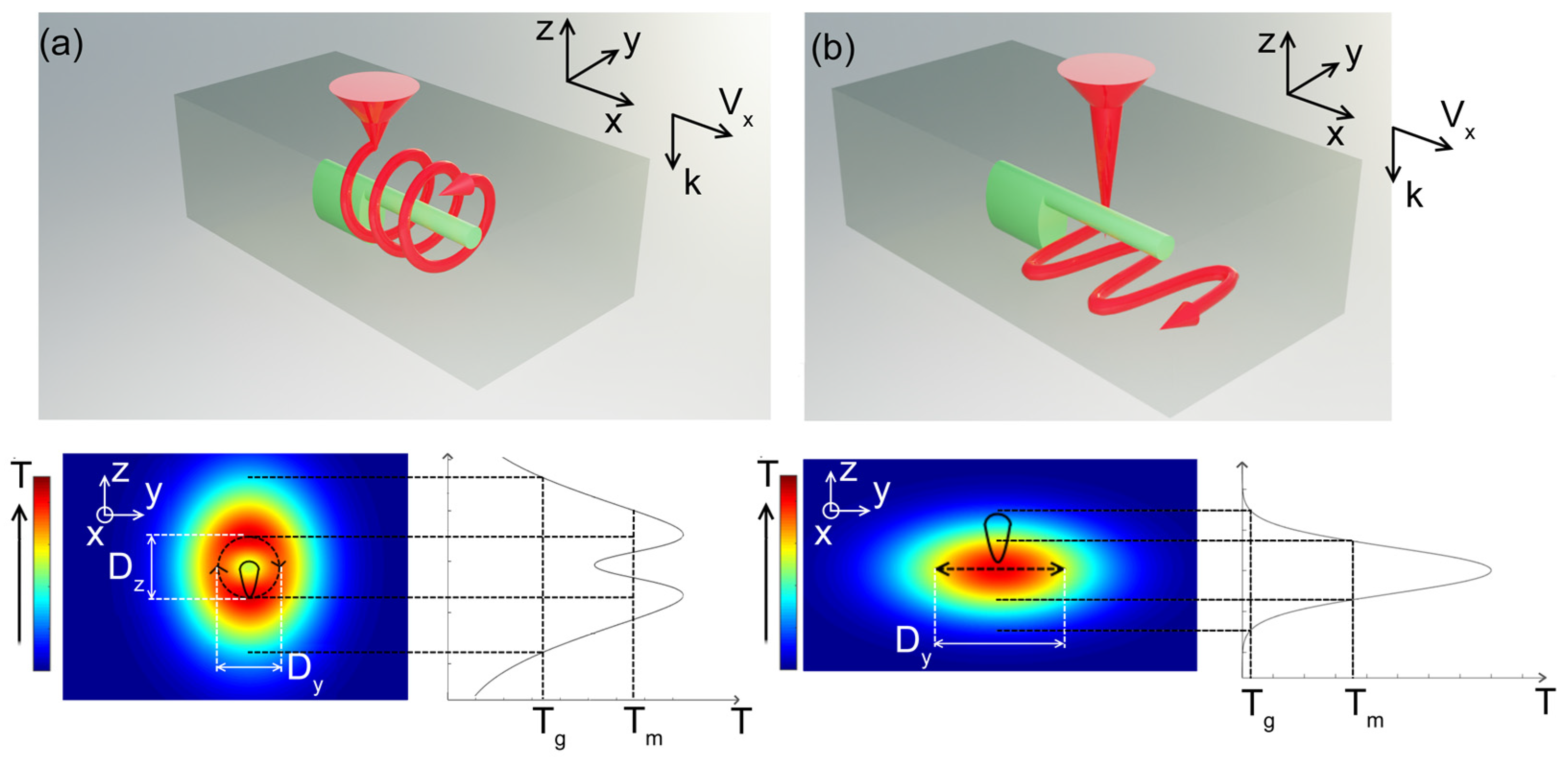
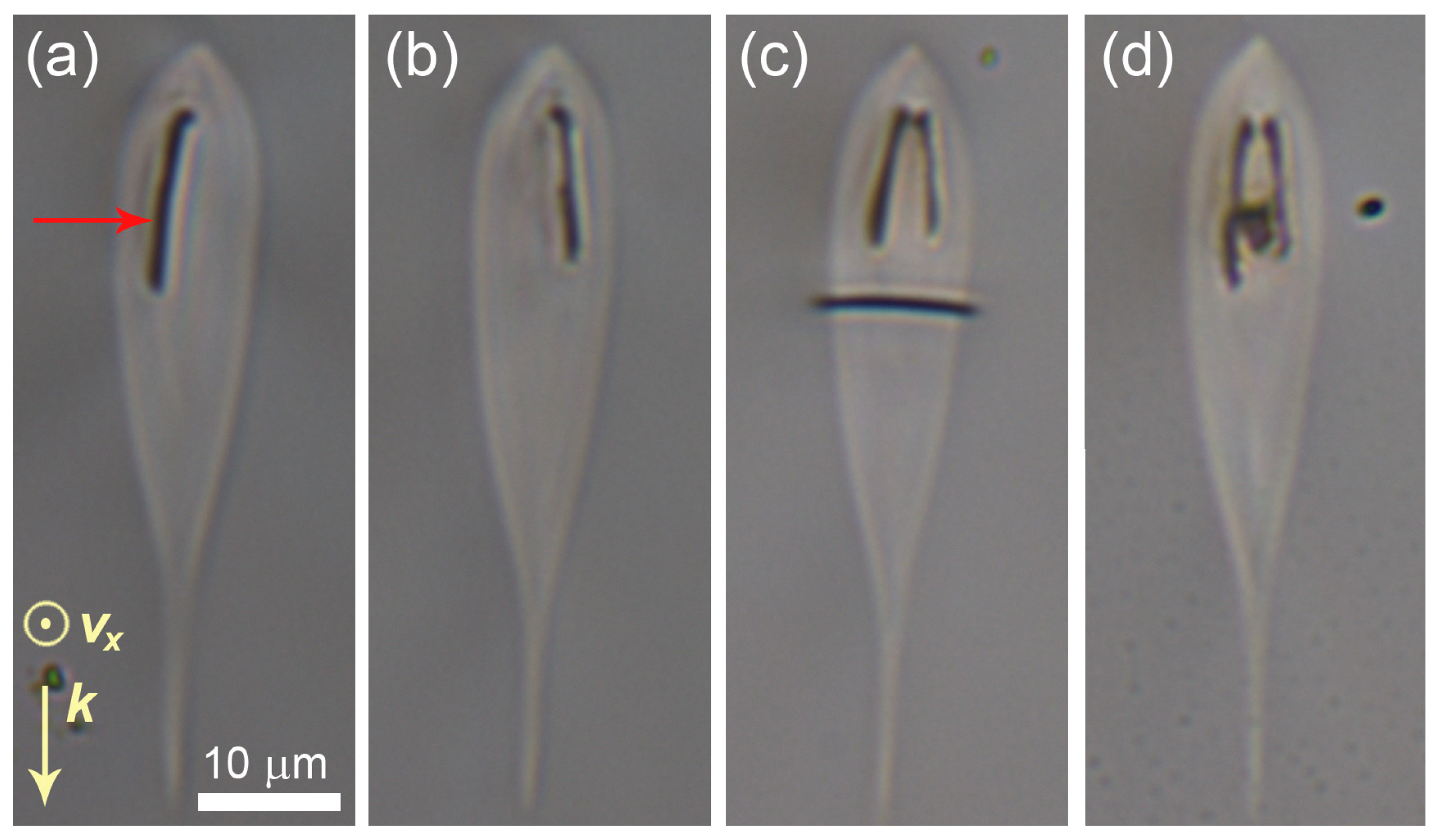
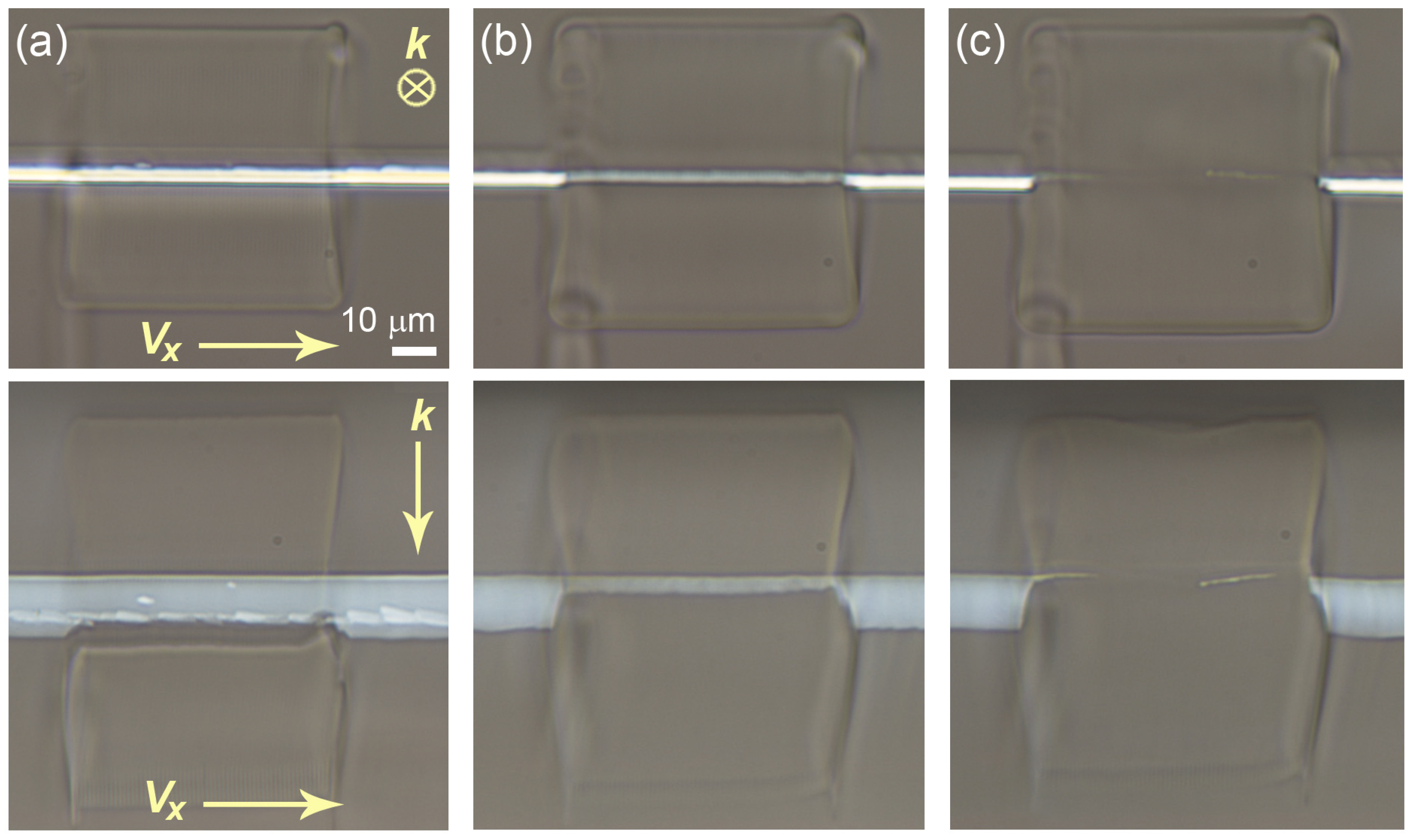
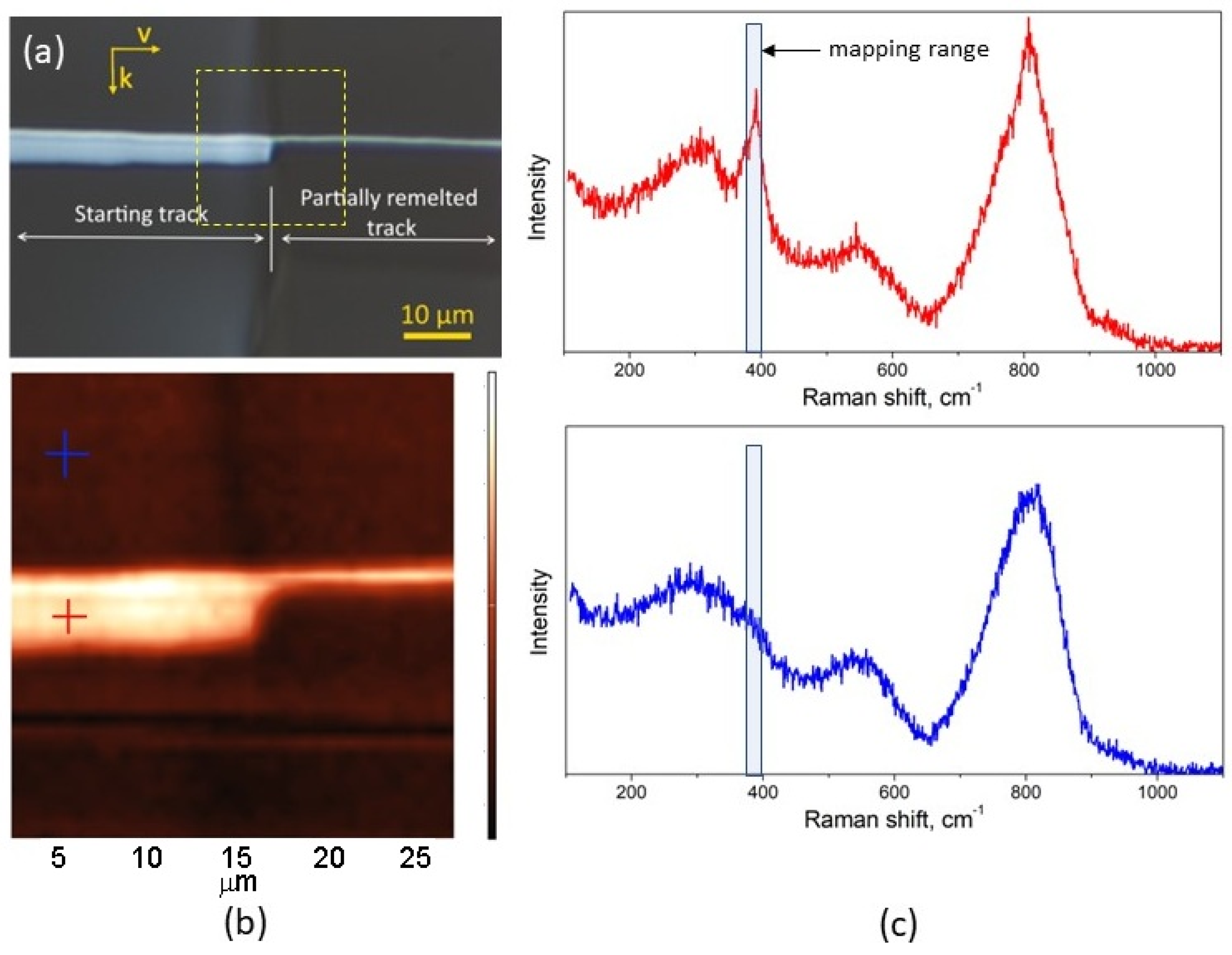

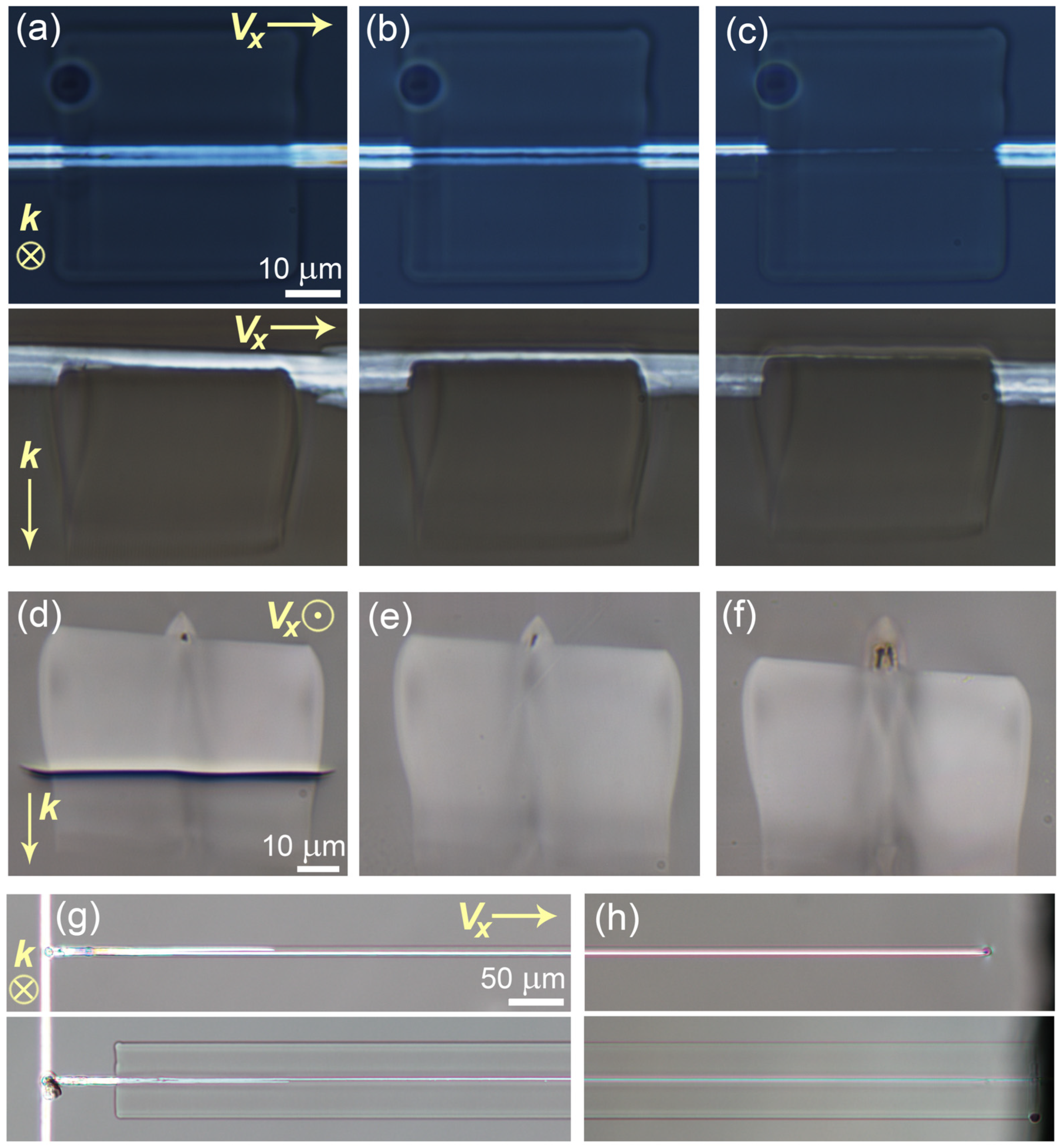

Disclaimer/Publisher’s Note: The statements, opinions and data contained in all publications are solely those of the individual author(s) and contributor(s) and not of MDPI and/or the editor(s). MDPI and/or the editor(s) disclaim responsibility for any injury to people or property resulting from any ideas, methods, instructions or products referred to in the content. |
© 2023 by the authors. Licensee MDPI, Basel, Switzerland. This article is an open access article distributed under the terms and conditions of the Creative Commons Attribution (CC BY) license (https://creativecommons.org/licenses/by/4.0/).
Share and Cite
Lipatiev, A.S.; Lotarev, S.V.; Lipateva, T.O.; Fedotov, S.S.; Lopatina, E.V.; Sigaev, V.N. Ultrafast-Laser-Induced Tailoring of Crystal-in-Glass Waveguides by Precision Partial Remelting. Micromachines 2023, 14, 801. https://doi.org/10.3390/mi14040801
Lipatiev AS, Lotarev SV, Lipateva TO, Fedotov SS, Lopatina EV, Sigaev VN. Ultrafast-Laser-Induced Tailoring of Crystal-in-Glass Waveguides by Precision Partial Remelting. Micromachines. 2023; 14(4):801. https://doi.org/10.3390/mi14040801
Chicago/Turabian StyleLipatiev, Alexey S., Sergey V. Lotarev, Tatiana O. Lipateva, Sergey S. Fedotov, Elena V. Lopatina, and Vladimir N. Sigaev. 2023. "Ultrafast-Laser-Induced Tailoring of Crystal-in-Glass Waveguides by Precision Partial Remelting" Micromachines 14, no. 4: 801. https://doi.org/10.3390/mi14040801
APA StyleLipatiev, A. S., Lotarev, S. V., Lipateva, T. O., Fedotov, S. S., Lopatina, E. V., & Sigaev, V. N. (2023). Ultrafast-Laser-Induced Tailoring of Crystal-in-Glass Waveguides by Precision Partial Remelting. Micromachines, 14(4), 801. https://doi.org/10.3390/mi14040801






